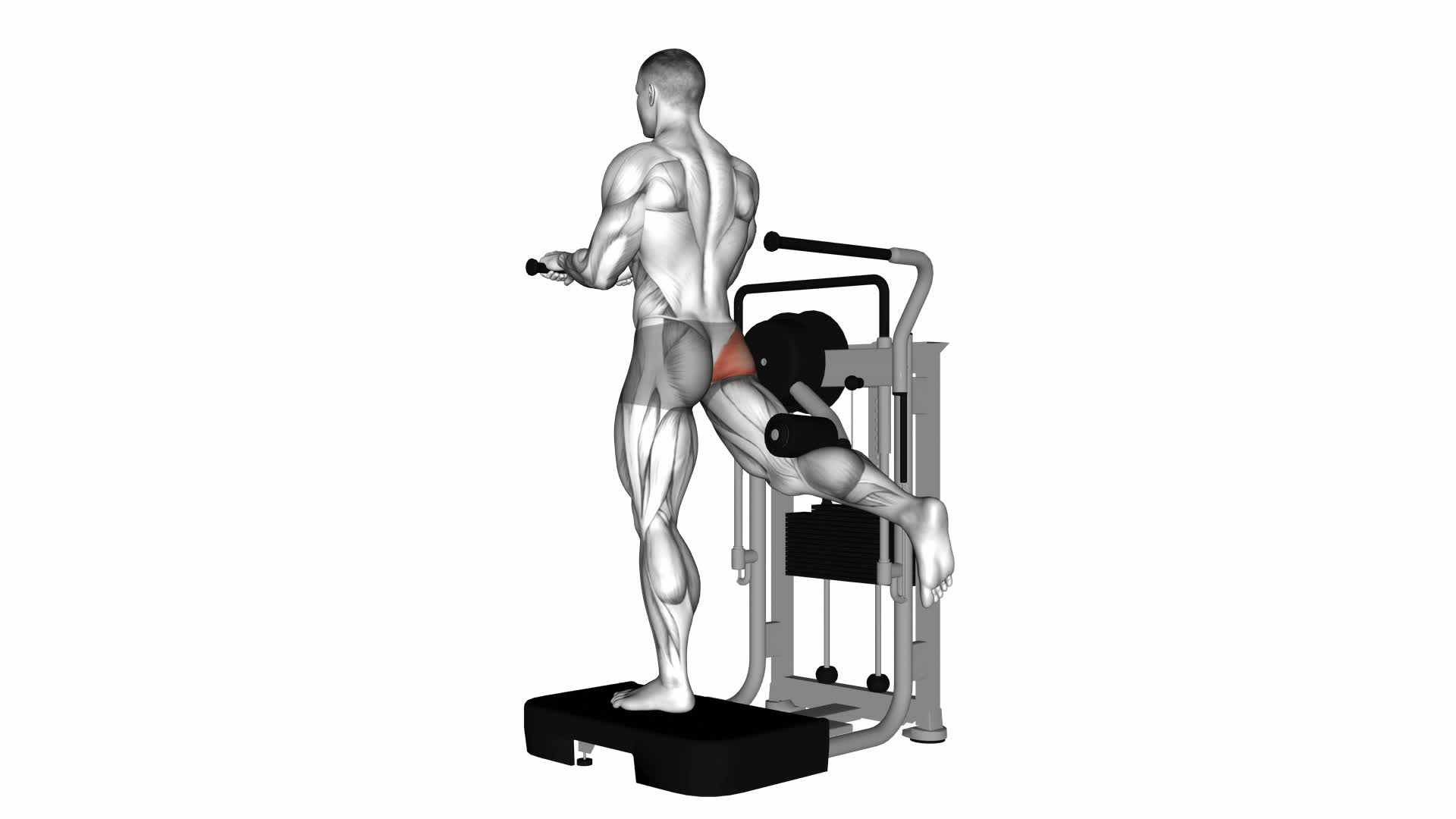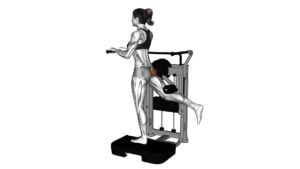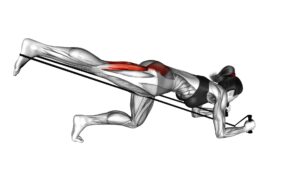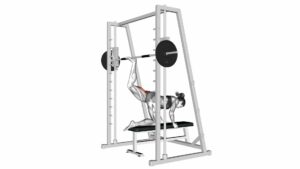Lever Standing Rear Kick – Video Exercise Guide & Tips

Looking to improve your kicking technique? Check out this video exercise guide for the Lever Standing Rear Kick! In just a few minutes, you'll learn the proper technique, common mistakes to avoid, and helpful tips to maximize the effectiveness of this powerful move.
Watch This Exercise Video
So, why wait? Get ready to take your kicking skills to the next level with this informative and easy-to-follow guide. Let's kick it!
Key Takeaways
- The lever standing rear kick targets the glutes, hamstrings, and quadriceps.
- It improves lower body strength, stability, balance, and coordination.
- The kick increases flexibility in the hip flexors and hamstrings.
- Proper technique, core engagement, and maintaining balance are crucial for an effective kick.
Benefits of the Lever Standing Rear Kick
You will experience several benefits from incorporating the lever standing rear kick into your workout routine. This exercise offers numerous advantages that can enhance your fitness journey. One of the key benefits is muscle engagement.
The lever standing rear kick targets multiple muscle groups, including the glutes, hamstrings, and quadriceps. By performing this exercise, you can strengthen and tone these muscles, leading to improved lower body strength and stability.
Additionally, the lever standing rear kick helps to improve your balance and coordination, as it requires control and precision in executing the movement. This exercise can also enhance your overall flexibility, particularly in the hip flexors and hamstrings.
By regularly incorporating the lever standing rear kick into your workouts, you can experience these benefits and take your fitness to the next level.
Now, let's shift our focus to the proper technique for the lever standing rear kick.
Proper Technique for the Lever Standing Rear Kick
To execute the lever standing rear kick with proper technique, begin by positioning your body in a stable and balanced stance. Stand with your feet shoulder-width apart, keeping your weight evenly distributed on both feet. Keep your knees slightly bent and your core engaged to maintain stability throughout the movement.
As you prepare to perform the rear kick, shift your weight onto your standing leg and slightly lean forward. This will help generate power and maintain balance during the kick. Keep your arms up and ready to defend yourself if necessary.
To execute the kick, lift your rear leg off the ground, bending your knee at a 90-degree angle. As you extend your leg, aim to strike your target with the heel or ball of your foot. Keep your toes pointed and your leg straight throughout the kick.
Common errors to watch out for include overextending the kick, which can compromise balance and leave you vulnerable to counterattacks. Additionally, avoid leaning too far back or forward, as this can disrupt your stability.
To progress in your training, start by practicing the technique slowly and with control. Focus on maintaining balance and proper form. As you become more comfortable, gradually increase the speed and power of your kicks.
Incorporating the lever standing rear kick into your regular training routine will improve your leg strength, flexibility, and overall martial arts skills.
Common Mistakes to Avoid When Performing the Lever Standing Rear Kick
Avoid these common mistakes when performing the lever standing rear kick to ensure proper technique and maximize your effectiveness.
One common mistake is failing to maintain a proper stance. Your feet should be shoulder-width apart, with your knees slightly bent and your weight evenly distributed. This stable base will help you generate power and maintain balance throughout the kick.
Another mistake is neglecting to engage your core muscles. Your core plays a crucial role in stabilizing your body and generating power for the kick. Make sure to tighten your core muscles by pulling your belly button towards your spine throughout the movement.
Additionally, many people make the mistake of not pivoting their supporting foot. As you extend your kicking leg, pivot your supporting foot to allow for a full range of motion and to generate more power.
Finally, it's important to avoid leaning back excessively during the kick. This can throw off your balance and compromise the power and accuracy of the kick. Instead, maintain an upright posture and focus on extending your leg and striking with the ball of your foot.
Variations and Modifications for the Lever Standing Rear Kick
Maintaining proper form and technique is essential when exploring variations and modifications for the lever standing rear kick. By incorporating different variations and modifications into your training routine, you can target specific muscle groups and add variety to your workouts.
One variation is the high lever standing rear kick, where you kick above waist level, challenging your flexibility and strength. Another variation is the low lever standing rear kick, where you kick below waist level, focusing on power and stability.
Additionally, you can modify the lever standing rear kick by using resistance bands or ankle weights to increase resistance and intensity. These modifications can help to further strengthen your leg muscles and improve overall kicking power.
As you explore these variations and modifications, it's important to listen to your body and start with lighter weights or lower intensity levels. This will allow you to gradually progress and avoid any potential injuries.
Now, let's move on to some tips to maximize the effectiveness of the lever standing rear kick.
Tips to Maximize the Effectiveness of the Lever Standing Rear Kick
Are you looking for ways to maximize the effectiveness of your lever standing rear kick? Here are some tips to help you improve your balance and target the right muscle groups:
- Engage your core: By tightening your abdominal muscles, you'll improve your stability and generate more power in your kick.
- Maintain proper posture: Keep your back straight and your chest lifted throughout the exercise. This will help you maintain balance and prevent unnecessary strain on your lower back.
- Focus on your hip extension: The lever standing rear kick primarily targets the glutes, hamstrings, and quadriceps. To fully engage these muscle groups, make sure to fully extend your hip as you kick backward.
Remember, balance is key when performing the lever standing rear kick. By practicing these tips, you can maximize the effectiveness of your kick and get the most out of your workout.
Keep in mind that it's always important to listen to your body and work within your own limits. Happy kicking!
Frequently Asked Questions
Can the Lever Standing Rear Kick Be Performed With Both Legs or Only One Leg?
You can perform the lever standing rear kick with both legs. It's a versatile exercise that targets your glutes, hamstrings, and quadriceps.
To progress in this exercise, start by mastering the technique on one leg, and then gradually work on incorporating both legs. This will challenge your balance and coordination while increasing the intensity of the exercise.
Remember to maintain proper form and engage your core for stability throughout the movement.
Is the Lever Standing Rear Kick Suitable for Beginners or Is It More Advanced?
The lever standing rear kick can be suitable for beginners, but it's also more advanced. It depends on your fitness level and experience. If you're a beginner, there are modifications you can make to make it easier, such as starting with a lower kick or using a support for balance.
This exercise has many benefits, including strengthening your glutes, hamstrings, and core, and improving your balance and stability.
How Many Repetitions and Sets Should Be Performed for the Lever Standing Rear Kick?
To determine the number of repetitions and sets for the lever standing rear kick, it's important to consider your fitness level and goals. Start with a manageable number, like 10 repetitions for 2 sets, and gradually increase as you become more comfortable and stronger.
Remember to listen to your body and take breaks when needed.
Consult with a fitness professional for personalized guidance and to ensure proper form and technique.
Can the Lever Standing Rear Kick Be Incorporated Into a Full-Body Workout Routine?
Yes, the lever standing rear kick can definitely be incorporated into a full-body workout routine.
It's a versatile exercise that can be modified for different fitness levels. Whether you're a beginner or an advanced athlete, you can adjust the intensity of the kick to suit your needs.
Furthermore, the lever standing rear kick is highly effective for targeting specific muscle groups, such as the glutes, hamstrings, and lower back.
It's a great addition to any comprehensive workout plan.
Are There Any Specific Warm-Up Exercises or Stretches Recommended Before Performing the Lever Standing Rear Kick?
Before performing the lever standing rear kick, it's important to warm up your muscles and do some stretching exercises. This will help prepare your body for the movement and reduce the risk of injury.
Some recommended warm-up exercises include jogging in place, jumping jacks, or arm circles.
As for stretching techniques, focus on stretching your hamstrings, quadriceps, and hip flexors.
Remember to listen to your body and never push yourself too hard during warm-up or stretching.
Conclusion
In conclusion, the Lever Standing Rear Kick is a highly effective exercise for strengthening the lower body and improving balance. By following proper technique and avoiding common mistakes, you can maximize the effectiveness of this exercise.
Additionally, there are variations and modifications available to suit different fitness levels and goals. Incorporating the Lever Standing Rear Kick into your workout routine can help you achieve greater strength and stability in your legs and hips.

Author
Years ago, the spark of my life’s passion ignited in my mind the moment I stepped into the local gym for the first time. The inaugural bead of perspiration, the initial endeavor, the very first surge of endorphins, and a sense of pride that washed over me post-workout marked the beginning of my deep-seated interest in strength sports, fitness, and sports nutrition. This very curiosity blossomed rapidly into a profound fascination, propelling me to earn a Master’s degree in Physical Education from the Academy of Physical Education in Krakow, followed by a Sports Manager diploma from the Jagiellonian University. My journey of growth led me to gain more specialized qualifications, such as being a certified personal trainer with a focus on sports dietetics, a lifeguard, and an instructor for wellness and corrective gymnastics. Theoretical knowledge paired seamlessly with practical experience, reinforcing my belief that the transformation of individuals under my guidance was also a reflection of my personal growth. This belief holds true even today. Each day, I strive to push the boundaries and explore new realms. These realms gently elevate me to greater heights. The unique combination of passion for my field and the continuous quest for growth fuels my drive to break new ground.







